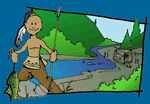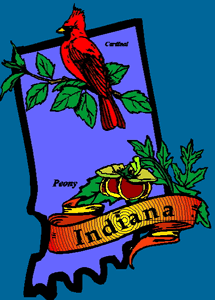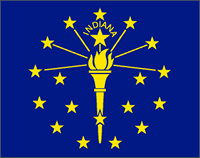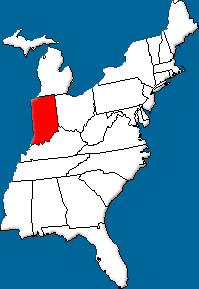


Geography and Landforms:
Due to its central location, Indiana has been called the "Crossroads of America."
The state is comprised of three main geographic regions. The Great Lakes Plains are located to the North. This area is marked by fertile lowlands, small lakes, moraines (low hills of rock and earth left by glaciers), and large sand dunes along the Lake Michigan shore line.
|
 History:
The first European explorer to come to Indiana was Robert Cavalier, Sieur de la Salle. He entered the region in 1679 from the Canadian French colonies, seeking a water route to the Pacific Ocean.
|
 Economy:
Manufacturing is an important part of Indiana's economy. Iron, steel, electrical and transportation equipment, chemicals, and food items are produced in industrial cities throughout the state. These include Evansville, Fort Wayne, Gary, Kokomo, South Bend, and Terre Haute. Indiana also has large deposits of coal and limestone, valuable resources used in industry and construction.
|
 First Inhabitants:
Indiana's earliest inhabitants were groups of Native Americans known as Mound Builders. Some of these prehistoric people were hunter-gatherers. Others were sedentary farmers. The mounds they left behind were constructed as burial sites, temples, platforms for religious structures, and earthen forts.
|
Books Related To IndianaThe Beef Princess of Practical County - Michelle Houts Buster on the Farm - Marc Brown Cover Up: Mystery at the Super Bowl - John Feinstein A Good Night for Freedom - Barbara Olenyik Morrow H is for Hoosier: An Indiana Alphabet - Bruce Langton Here Lies the Librarian - Richard Peck Learning the Game - Kevin Waltman My Brother Abe: Sally Lincoln's Story - Harry Mazer Running out of Time - Margaret Haddix The School at Crooked Creek - Laurie Lawlor Teen Idol - Meg Cabot Throwing Stones - Kristi Collier |
Famous Citizens:
|
| Capital: | Indianapolis |
| Entered Union: | December 11, 1816 |
| Population: | 6,596,855 |
| Area | 36,418 |
| Bird | Cardinal |
| Flower | Peony |
| Nickname: | Hoosier State |
| Governor | Mike Pence |
Places to Visit in Indiana: (Click the links to learn more.)
|



